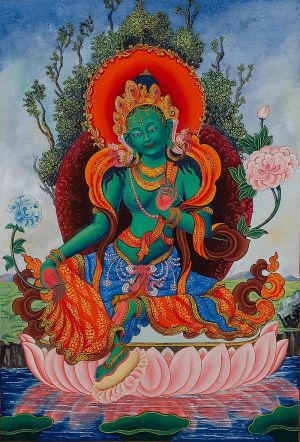Madhyamaka and Yogacara Buddhism II After Siddhartha
Madhyamaka and Yogacara Buddhism II After Siddhartha
Buddhism split into two major traditions: Theravada & Mahayana
Theravada – the doctrine of the elders
Mahayana – the “large raft/vehicle” also called “the great course” – more popular and designed for laypeople as well as scholars.
After Siddhartha: Theravada
Core text: The Pali Canon
Life style: emphasis on monastic life, with strict adherence to the vinaya – rules of conduct.
Ideal: the Arhant – “Noble one” or being of perfect knowledge Primary schools:
Abhidharmists - Described self in terms of elements called Dharmas. Two categories: Nama: Mental processes/Rupa: bodily processes – these should be compared to energy rather than mass – they have no duration nor extension. This school included many subgroups some of which are the Sarvastivadins, Sautrantikas, and Vaibhashikas.
Pudgalavadins – worked on the concept of the pudgala or self which correlated with the elements – this person performed the task of memory, continuity, enlightenment, etc.
After Siddhartha: Mahayana
Core text: The Prajnaparamita
Key focus: Karuna – compassion
Lifestyle: both laypersons and monks – many laypersons spend early years as monks & nuns before becoming householders & parents
Ideal: the Bodhisattva – or being of infinite compassion Primary schools:
Mahyamaka – analysis of shunyata
Yogacara – analysis of consciousness
The Qualities of the Bodhisattva:
To become a buddha, a
bodhisattva has to practice six perfections (paramita):
the perfection of giving (dana paramita)
the perfection of morality (shilaparamita)
the perfection of patience (kshanti-paramita)
the perfection of energy (viryaparamita)
the perfection of meditation
the perfection of wisdom (prajnaparamira)
Mural of Padmapani from Ajanta Caves, India,
5th century
http://www.nationalgeographic.ru/ngm/200801/article_168/gal lery_1394/ The Rise of Mahayana Philosophy
Perfection of Wisdom (Prajnaparamita) Texts
Diamond Sutra – The Diamond That Cuts Through Illusion – focus on interdependent arising
Heart Sutra – focus on emptiness
Painting of Prajnaparamita personified. Sanskrit Astasahasrika Prajnaparamita Sutra manuscript written in the Ranjana script. Nalanda, Bihar, India. Circa 7001100 CE.
Madhyamaka Overview
Name means “Middle Way” because neither nihilism (nothing exists) nor realism (everything self-exists & is permanent) is endorsed Founded by Nagarjuna in 2nd C. BCE
Method of analysis is the “critical dialectic” or “reductio ad absurdum” logical form of reasoning (latin for “reduction to the absurd”)
Explanation of reality focused on “shunyata”
Nagarjuna’s Method:
the “critical dialectic” or “reductio ad absurdum”
“Reductio ad absurdum is a mode of argumentation that seeks to establish a contention by deriving an absurdity from its denial, thus arguing that a thesis must be accepted because its rejection would be untenable.”
(Internet Encyclopedia of Philosophy)
Nagarjuna applies this method to claims about: causality, motion, self, the Buddha, the Four Noble Truths and nirvana.
Following is an example of this method applied to causation.
Nagarjuna’s Method:
Argument against causation:
P1) Either an effect produces itself or is produced by something other than itself, or both produces itself and is produced by something other than itself or it is produced without a cause.
P2) an effect cannot produce itself because then the cause and effect would be identical which is to deny causality entirely
P3) the idea that an effect is produced by something entirely different than itself implies that it would be impossible to have a causal relationship between two fundamentally different things
P4) the idea that an effect is both produced by itself and something else is just a conjunct of the first two ideas (P2 & P3) so since they have been shown to be false so must their conjunct be false
P5) the last idea that nothing can produce something is also to abandon causality entirely. _____________________________________________________ C) Causality based on the independence of cause and effect is absurd
Nagarjuna’s Conclusions
On Sunyata:
“Empty” should not be asserted.
“Non-empty” should not be asserted.
Neither both nor neither should be asserted.
They are only used nominally.
Fundamental Verses, Chapter 22, verse 11
“Whoever sees interdependent arising also sees duhkha, its arising, its cessation, and also the path.”
Fundamental Verses, Chapter 24, verse 18
Yogacara Overview
Founded by Asanga (ca.365-440 BCE) and his brother, Vasubandhu (ca 380-460 BCE)
Name from yoga - discipline and cara – practice
Focus principally on analysis of consciousness and knowledge
Emphasis placed on things as “tathata” – things are what they are such as they are
Three Aspects of Knowledge – how a thing can be known:
Through conceptual constructs – these are signs that point at the thing but are not the thing itself
Through conditioning by other things – understanding how that thing relates, arises, & inter-exists with other things – still conceptual though & not the thing itself
As it is in itself – such as it is – tathata – free from conceptual constructs Yogacara on Consciousness
Knowledge is a function of consciousness so to understand the former, the Yogacara analyzed the latter. Two Kinds of Consciousness: Ordinary, discursive & dualistic consciousness – subject and object are thought of as separate though the relationship of knower and known is identified – in this way it can be defiled through grasping and attaching
Store or Seed Consciousness – alaya vijnana – this is the well from which ordinary consciousness arises and back into which it subsides – like a storehouse or repository of thought and experience. In itself, it is free from dualism and discursiveness. This idea can be used to explain the continuity of personality, of memory & of karma/kamma
Three Foundations of Knowledge:
Knowledge based on shared opinion and general correspondence to practice
Knowledge based on scientific testing
Knowledge free from discursiveness & personal defilements
– insight/direct experience of reality in itself – no
subject/object distinction – also called the knowledge of the Bodhisattvas & Buddhas
